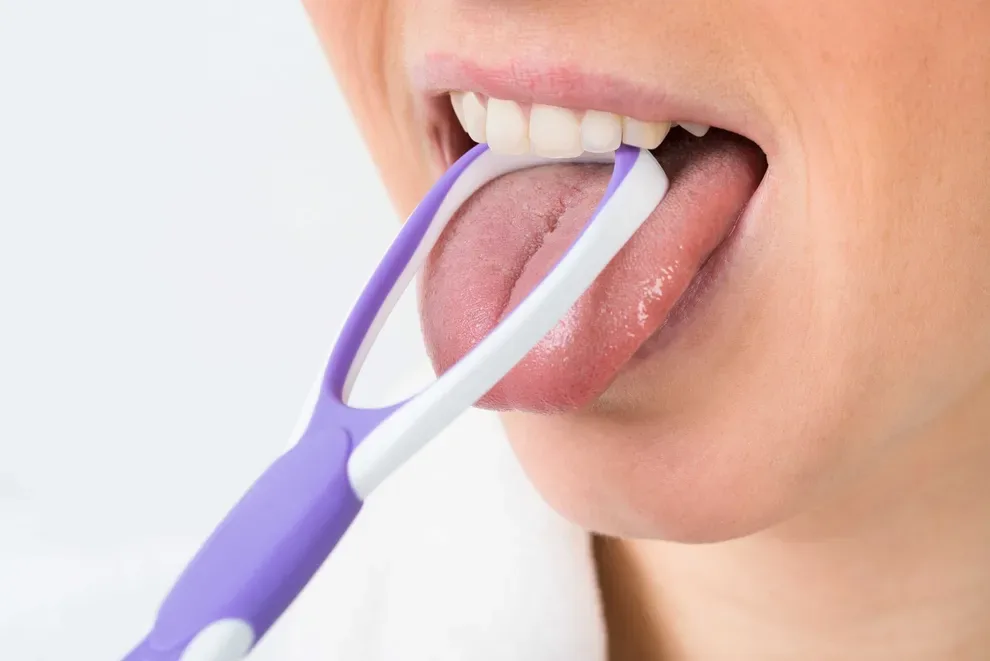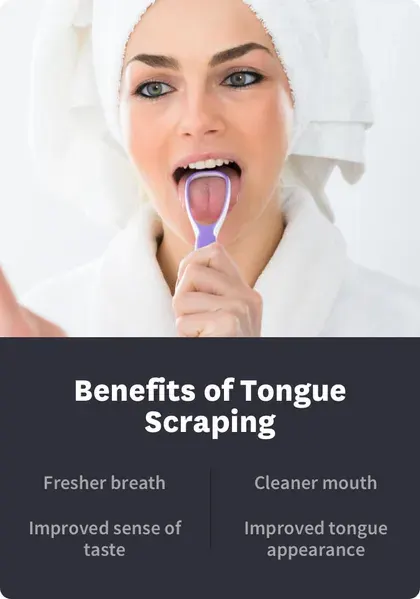How to Scrape Your Tongue: Brushes, Scrapers & Spoons

Table of Contents
- How to Scrape Your Tongue
- Do Tongue Cleaners Work
- Tongue Brushes
- Tongue Scrapers
- Cutlery Drawer Spoons
- Benefits
- Bad Breath and Your Health
- References
To scrape your tongue with a dedicated device, a brush like a toothbrush, or even a simple utensil like a spoon, you simply pull the instrument down from the back of the tongue to the front.
This has become a popular way to “eliminate” bad breath. However, there is little evidence that cleaning your tongue like this works to get rid of bad breath.
Tongue scraping might help a bit to lessen some bad breath if it’s used as part of a standard oral hygiene routine. But it won’t be sufficient on its own to address bad breath.
How to Scrape Your Tongue
No matter what tool you are using — your toothbrush, an inverted spoon, or a designated tongue scraper — there is a specific way to scrape your tongue properly.
Be sure to use a proper tool when you are scraping your tongue. Then, follow these steps:
While standing in front of a mirror, open your mouth and stick out your tongue.
Place the rounded edge of the tongue scraper, the tip of your toothbrush, or a spoon at the back of your tongue.
Initially, you may need to start more toward the middle of your tongue to avoid triggering your gag reflex. As you become more accustomed to tongue scraping, you can gradually move the scraper further back.
With gentle pressure, pull the tongue scraper from the back of your tongue slowly and carefully to the tip of your tongue. Always use a pulling motion from the back to the front. Do not use a pushing motion going the opposite direction, from the front to the back.
After scraping, remove debris from the scraper with a washcloth or tissue.
Scrape your tongue in sections, repeating these steps until the entire tongue has been scraped. Remember to wipe the scraper after every scrape. You can scrape each section of tongue one to two times.
Wash the tongue scraper with warm water and soap. If using a spoon, put it in the dishwasher. Store it in a clean and dry area.
Scraping your tongue generally takes no longer than two minutes. You can repeat this process throughout the day as needed.
Tongue scraping can easily be added to your mouth and teeth cleaning routine. For example, scrape your tongue before brushing your teeth.
Clean Tongues: Do Devices to Clean Your Tongue Help?
Tongue scrapers are tools used to scrape “gunk” off your tongue. This may include food, plaque, patches of bacteria that can cause bad breath, or other unsavory messes.
The concept of tongue scraping has been part of several human cultures for thousands of years. Like many other oral health trends, it is seeing a revival in the Western world.
Although tongue scraping is not a replacement for a good oral hygiene routine that includes brushing and flossing your teeth at least twice per day, adding tongue scraping to this routine may help you reduce problems you have with bad breath. The process of cleaning your tongue may remove particles that cause bad breath, called volatile sulphur compounds (VSCs).
If you struggle with consistent or chronic halitosis, you should visit a dentist to see if you have any underlying conditions like gingivitis that may be contributing to the problem.
The term tongue scraper covers many different devices that include dedicated scrapers, specific brushes, toothbrushes, or even unrelated devices like spoons.
Tongue Brushes
One of the simplest ways to begin cleaning your tongue or “scraping” it is to simply use your toothbrush. Once you have finished brushing your teeth for two minutes, you can use your toothbrush to clean your gums and your tongue too. Then, continue with your oral care routine, which should include flossing or using interdental brushes and rinsing with a mouthwash.
Some people buy brushes that are specifically made for their tongues or keep a separate toothbrush to use on their tongue. As long as you keep your toothbrush clean and in good shape, replacing it every three to four months or when the bristles fray, you can use your regular toothbrush on your tongue as well.
Studies show, using a tongue scraper twice a day for seven days reduces two forms of bacteria in the mouth.
Tongue Scrapers
Tongue scrapers are devices that are specifically designed to remove the coating on your tongue, which may contain some bacteria or VSCs that contribute to bad breath. Medical studies show inconclusive evidence of their effectiveness, however.
For example, one of the earlier tongue scraping reviews, published in 2006, reported that there was “weak and unreliable evidence” to support tongue scraping over other types of tongue cleaning, including with your existing toothbrush. A later review, in 2019, from the same publication, found that two different studies showed tongue scraping could create a small improvement in bad breath by removing tongue coating, which may include some VSCs.
A tongue scraper may be made out of plastic, a nonreactive metal like stainless steel, or a combination of the two.
Like your toothbrush, it is important to keep your tongue scraper clean by rinsing it after you use it. Store it in an upright position in open air so it can quickly dry.
Spoons From Your Cutlery Drawer
If you don’t want to use your toothbrush but don’t want to invest in a tongue scraper, or you are simply curious whether tongue scraping or cleaning is for you before you invest in the process, you can use a spoon out of your cutlery drawer. It is important to use a wider spoon, like a soup spoon, rather than a teaspoon. Choose a spoon that does not have sharp edges, which might harm the surface of your tongue.
Spoons might be a great option because you can clean them in your kitchen sink or dishwasher rather than storing them with your toothbrush. You may feel that this is a more hygienic solution than a scarper or a brush.
Still, the effects of tongue scraping with a spoon are like those of using a scraper or a brush. It might help to improve halitosis by removing some particles, but it is more important to maintain a strong oral hygiene routine.
The Benefits of Tongue Scraping

Adding a tongue scraper or cleaner to your oral care routine offers several benefits.
Scraping your tongue can remove food particles that are stuck to it, even after you brushed and flossed your teeth. This can reduce bad breath much more effectively than eating mints or chewing gum.
Paradoxically, mints and gum may actually increase bad breath. As food particles are freed, they might release volatile sulfur compounds (VSCs) as they break down in your mouth, leading to bad breath.
Your saliva naturally helps to cleanse your mouth and teeth, but sometimes, particles and bacteria from your saliva can collect on your tongue, which can increase bad breath, stains on teeth, and oral health risks. Stubborn food particles are a boon for harmful bacteria. When these microbes grow, they not only cause bad breath, but they also increase your risk of gum disease and tooth decay.
By removing residual food particles, you unclog your taste buds, giving them more surface area and reducing the presence of other flavors. This is not only pleasurable in the short term but also better for your long-term health. Enjoying the food you eat helps to regulate your emotions and your sense of satiation.
Not many people think about what their tongue looks like until it is coated with an unattractive whitish film. Tongue scrapers help remove this, prevent the coating from returning, and ensure the tongue is a healthy color.
If you want to boost the benefits of your oral health routine, add tongue scraping to brushing, flossing, and using mouthwash. This practice can reduce how often you experience bad breath, increase your oral health, and even improve your experience of the world around you.
Bad Breath Can Mean Underlying Health Problems
The American Dental Association states that there is currently no evidence that proves that keeping your tongue clean can reduce bad breath or improve oral hygiene.
Tongue scraping may provide a short-term solution, but if you have ongoing concerns about halitosis, you may have an underlying problem like gingivitis that requires treatment from a dentist or dental hygienist.
You may simply prefer the way your tongue feels after cleaning it with a brush, scraper, or spoon, and this is a perfectly valid reason to continue. Cleaning your tongue might slightly improve your oral hygiene, and it certainly will not harm your oral health.
